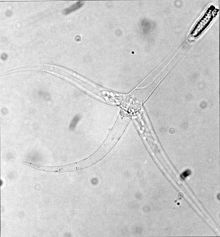
Back Myxozoa Afrikaans مواخط Arabic مواخط ARZ Myxozoa Azerbaijani Myxozoa BS Mixozous Catalan Výtrusenky Czech Myxozoa Danish Myxozoa German Miksozooj Esperanto
| Myxozoa | |
|---|---|

| |
| Triactinomyxon stage of Myxobolus cerebralis | |
| Scientific classification | |
| Domain: | Eukaryota |
| Kingdom: | Animalia |
| Phylum: | Cnidaria |
| Subphylum: | Myxozoa Grassé, 2021 |
| Classes | |
Myxozoa (etymology: Greek: μύξα myxa "slime" or "mucus"[1] + thematic vowel o + ζῷον zoon "animal"[2]) is a subphylum of aquatic cnidarian animals – all obligate parasites. It contains the smallest animals ever known to have lived. Over 2,180 species have been described and some estimates have suggested at least 30,000 undiscovered species.[3] Many have a two-host lifecycle, involving a fish and an annelid worm or a bryozoan. The average size of a myxosporean spore usually ranges from 10 μm to 20 μm,[4] whereas that of a malacosporean (a subclade of the Myxozoa) spore can be up to 2 mm. Myxozoans can live in both freshwater and marine habitats.
Myxozoans are highly derived cnidarians that have undergone dramatic evolution from a free swimming, self-sufficient jellyfish-like creature into their current form of obligate parasites composed of very few cells – sometimes only a single cell [citation needed]. As myxozoans evolved into microscopic parasites, they lost many genes responsible for multicellular development, coordination, cell–cell communication, and even, in some cases, aerobic respiration. The genomes of some myxozoans are now among the smallest genomes of any known animal species.[5][6]
- ^ μύξα. Liddell, Henry George; Scott, Robert; A Greek–English Lexicon at the Perseus Project
- ^ ζῷον. Liddell, Henry George; Scott, Robert; A Greek–English Lexicon at the Perseus Project
- ^ Atkinson, Stephen D.; Bartholomew, Jerri L.; Lotan, Tamar (1 August 2018). "Myxozoans: Ancient metazoan parasites find a home in phylum Cnidaria". Zoology. 129: 66–68. Bibcode:2018Zool..129...66A. doi:10.1016/j.zool.2018.06.005. ISSN 0944-2006. PMID 30170750. S2CID 52141614.
- ^ Fiala, Ivan (10 July 2008). "Myxozoa". tolweb.org (under construction). The Tree of Life Web Project.
- ^ Chang, E. Sally; Neuhof, Moran; Rubinstein, Nimrod D.; Diamant, Arik; Philippe, Hervé; Huchon, Dorothée; Cartwright, Paulyn (1 December 2015). "Genomic insights into the evolutionary origin of Myxozoa within Cnidaria". Proceedings of the National Academy of Sciences. 112 (48): 14912–14917. Bibcode:2015PNAS..11214912C. doi:10.1073/pnas.1511468112. ISSN 1091-6490. PMC 4672818. PMID 26627241.
- ^ Yahalomi, D.; Atkinson, S.D.; Neuhof, M.; Chang, E.S.; Philippe, H.; Cartwright, P.; Bartholomew, J.L.; Huchon, D. (24 February 2020). "A cnidarian parasite of salmon (Myxozoa: Henneguya) lacks a mitochondrial genome". Proceedings of the National Academy of Sciences. 117 (10): 5358–5363. Bibcode:2020PNAS..117.5358Y. doi:10.1073/pnas.1909907117. PMC 7071853. PMID 32094163.